What is Vabbing at the Gym
Vabbing at the gym has been gaining popularity in recent years, but what exactly is it and is it truly effective? Vabbing, short for “vibration training,” involves using vibrating platforms or machines to enhance workouts. These devices produce rapid vibrations that are believed to stimulate muscle contractions and improve strength and flexibility.
Advocates of vabbing claim that it can accelerate weight loss, increase muscle tone, and even improve circulation. The theory behind this technique is that the vibrations force your muscles to contract more frequently than they would during traditional exercises, leading to greater activation and potential gains.
However, while some studies suggest that vabbing may have benefits such as improved balance and enhanced bone density, the overall effectiveness of this training method remains a subject of debate among fitness professionals. Critics argue that any benefits observed could be attributed to the additional effort put into exercising on a vibrating platform rather than the vibrations themselves.
Ultimately, whether vabbing is effective or not may depend on individual preferences and goals. While some people may find value in incorporating vibration training into their fitness routine, others might prefer sticking with traditional exercises known for their proven results. As with any new exercise trend, it’s important to consult with a qualified fitness professional before embarking on a vabbing regimen to ensure proper technique and minimize the risk of injury.
What is Vabbing?
Definition of Vabbing
Vabbing, short for “Variable Airflow Breathing,” is a fitness technique that involves controlling and manipulating the air intake during exercise. It focuses on regulating the amount of airflow through the nasal passages to enhance performance and improve overall fitness outcomes. By adjusting the resistance and flow of air while breathing, vabbing aims to optimize oxygen uptake, strengthen respiratory muscles, and increase endurance levels.
The concept behind vabbing draws inspiration from various breathing techniques used in practices like yoga and meditation. However, it has been adapted specifically for gym workouts to maximize physical exertion and efficiency. The idea is that by consciously modifying your breath patterns during exercise, you can optimize oxygen utilization, reduce fatigue, and potentially achieve better results in terms of strength gains or weight loss.
History of Vabbing
While vabbing may be a relatively new term in the fitness world, variations of controlled breathing techniques have been practiced for centuries in different cultures worldwide. In ancient disciplines such as Pranayama (a yogic practice) or Qigong (a Chinese martial art), individuals have long recognized the power of intentional breath control for enhancing mental focus, energy flow, and physical performance.
In recent years, vabbing has gained popularity among athletes and fitness enthusiasts seeking innovative methods to amplify their workouts. It has emerged as a trend within the broader field of respiratory training techniques designed to optimize athletic performance. With proponents advocating its potential benefits such as improved cardiorespiratory function and increased stamina, more people are incorporating vabbing into their exercise routines.
As with any emerging fitness trend or technique, it’s essential to approach vabbing with an open mind while considering individual preferences and goals. While some individuals report positive experiences with vabbing at the gym – including enhanced concentration during workouts or increased endurance – there is still ongoing debate within the scientific community regarding its effectiveness and universal applicability.
In the next sections, we will dive deeper into the potential benefits and limitations of vabbing, exploring whether it lives up to the hype and if it’s a worthwhile addition to your fitness routine. Stay tuned!
Remember to consult with a healthcare professional or certified trainer before adopting any new exercise techniques, including vabbing. Their expertise can ensure that you engage in safe and appropriate practices tailored to your specific needs and abilities.

Benefits of Vabbing at the Gym
Increased Muscle Activation
One of the key benefits of vabbing at the gym is the increased muscle activation it offers. Vabbing, short for variable angle benching, involves performing exercises on an adjustable bench that allows you to target different angles and positions. This variation in angles helps activate a wider range of muscles than traditional exercises.
For example, when performing a chest press on a standard flat bench, you primarily target your pectoral muscles. However, with vabbing, you can adjust the bench to incline or decline positions, engaging not only your chest but also your shoulders and triceps to a greater extent. This added muscle activation leads to more comprehensive strength and muscle development throughout your upper body.
Studies have shown that vabbing can significantly increase muscle activation compared to traditional exercises. In fact, research published in the Journal of Strength and Conditioning Research found that incline vab pressing activated significantly more upper pecs and anterior deltoids than flat bench pressing alone.


